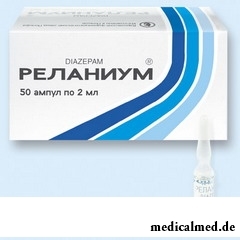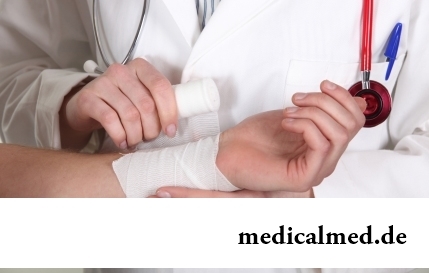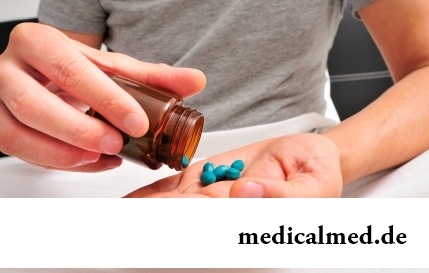





Relanium
Application instruction:
 Relanium – a tranquilizer (anxiolytic).
Relanium – a tranquilizer (anxiolytic).
Form of release and structure
Dosage form – solution for intravenous and intramuscular administration: flavovirent or colourless, transparent (on 2 ml in ampoules, on 5 ampoules in the plastic holder, in a pack of cardboard 1, 2 or 10 holders).
Active ingredient: diazepam – 5 mg in 1 ml.
Additional components: benzyl alcohol, acetic acid ice, ethanol of 96%, acetic acid of 10% (to рН 6,3-6,4), Natrium benzoicum, propylene glycol, water for injections.
Indications to use
- Treatment of the neurosis-like and neurotic frustration which are followed by manifestations of alarm;
- Therapy of the states which are followed by increase in a muscle tone (including acute disorders of cerebral circulation and tetanus);
- Stopping of convulsive states and epileptic seizures of various etiology;
- Stopping of the psychomotor excitement connected with alarm;
- Stopping of an abstinence syndrome and delirium at alcoholism;
- Complex treatment of the arterial hypertension which is followed by a hyperexcitability and alarm and also vasospasms, hypertensive crisis, menstrual and climacteric frustration.
Also Relanium is applied to an ataralgeziya and premedication in obstetric and surgical practice when holding diagnostic procedures (in a combination with analgetic and other neurotropic means).
Contraindications
Absolute:
- Syndrome of a night apnoea;
- Closed-angle glaucoma;
- Severe form of a myasthenia;
- Shock;
- Coma;
- Acute respiratory insufficiency;
- Serious chronic obstructive illness of lungs;
- Alcohol intoxication;
- Alcohol or drug addiction in the anamnesis (except for a tremens and an abstinence syndrome);
- Pregnancy period (especially I and III trimesters) and lactations;
- Children's age up to 30 days inclusive;
- Acute intoxication medicines which have the oppressing effect on the central nervous system (psychotropic, hypnotic drugs and drugs);
- Hypersensitivity to components of drug or other benzodiazepines.
Relative:
- Absentias epileptica (petit mal);
- Lennox-Gasto's syndrome;
- Epilepsy and epileptic seizures in the anamnesis;
- Liver and/or renal failure;
- Spinal and cerebral ataxy;
- Hyperkinesia;
- Organic diseases of a brain;
- Depression;
- Tendency to abuse of psychotropic drugs;
- Hypoproteinemia;
- Advanced age.
Route of administration and dosage
Relanium enter intravenously (in/in) or intramusculary (in oil).
The recommended dosages:
- Stopping of the psychomotor excitement connected with alarm: in/in on 5-10 mg once, if necessary in 3-4 hours the drug is administered repeatedly in the same dose;
- Epileptic status: in/in or 10-20 mg in oil once, if necessary repeat introduction in a similar dose in 3-4 hours;
- Tetanus: in/in slowly or in oil it is deep in a dose of 10 mg, then in/in kapelno with a speed of 5-15 mg/h of 100 mg of 500 ml of solution of sodium of chloride of 0,9% or solution of glucose of 5%;
- Spasmolysis of skeletal muscles: 10 mg in oil in 1-2 hours prior to operation;
- In obstetrics: 10-20 mg in oil at disclosure of a neck of uterus on 2-3 fingers.
The newborn 30 days Relanium are more senior enter slowly in/in 0,1-0,3 mg/kg to the maximum dose of 5 mg. If necessary the drug is administered repeatedly in 2-4 hours.
To children of 5 years means is entered slowly in/in on 1 mg by each 2-5 minutes to the maximum dose of 10 mg. If necessary in 2-4 hours it is entered repeatedly.
Side effects
- Allergic reactions: skin rashes, itch;
- From the central and peripheral nervous system: in an initiation of treatment (especially at elderly people) – increased fatigue, dizziness, disturbance of concentration of attention, drowsiness, an ataxy, delay of mental and motor reactions, obtusion of emotions, a disorientation, an ecmnesia; seldom – a katalepsy, a tremor, confusion of consciousness, a depression, dystonic extrapyramidal reactions (the uncontrollable movements), a hyporeflexia, muscular weakness, euphoria, a dysarthtia, an adynamy, a headache; in some cases – paradoxical reactions (sleep disorders, psychomotor arousing, a muscular spasm, alarm, fear, confusion of consciousness, flash of aggression, a hallucination, suicide bents);
- From the alimentary system: hypersalivation or dryness in a mouth, abnormal liver functions, a hiccups, nausea, vomiting, a lock, a gastralgia, heartburn, a loss of appetite, jaundice, increase in activity of hepatic transaminases and an alkaline phosphatase;
- From system of a hemopoiesis: an agranulocytosis (the expressed fatigue or weakness, a pharyngalgia, a hyperthermia, a fever), a neutropenia, a leukopenia, anemia, thrombocytopenia;
- From a reproductive system: dysmenorrhea, increase or decrease in a libido;
- From respiratory system: at too bystry administration of drug – respiratory depression;
- From an urinary system: renal failure, incontience or ischuria;
- From cardiovascular system: tachycardia, arterial hypotension;
- Local reactions: phlebitis or venous thrombosis (pain, a swelling, redness) in an injection site;
- Others: medicinal dependence, accustoming; seldom – decrease in body weight, bulimia, a diplopia, oppression of a respiratory center.
At sharp reduction of a dose or the termination of reception the withdrawal which is shown the following symptoms can develop: sweating strengthening, tremor, depersonalization, psychomotor excitement, headache, acrimony, spasm of unstriated muscles of internals and skeletal muscles, dysphoria, nausea, vomiting, fear, depression, sleep disorders, alarm, disorders of perception, including hyperacusia, photophobia, paresthesias, hallucinations, spasms, tachycardia; seldom – psychotic frustration.
At use in obstetrics for newborns the hypothermia, a hypomyotonia, a lowering of arterial pressure, the weak act of suction are possible диспноэ.
Special instructions
Patients should appoint Relanium with extra care with a heavy depression as they can use drug for implementation of suicide intentions.
Intravenously solution needs to be entered into a large vein, slowly, not quicker than 5 mg (1 ml) a minute. It is not recommended to carry out continuous intravenous infusions since formation of a deposit in solution and drug adsorption by materials from polyvinylchloride of infusional tubes and cylinders is possible.
At the beginning of use of Relanium and at its sharp cancellation at patients with epileptic seizures or epilepsy in the anamnesis acceleration of development of attacks or the epileptic status is possible.
Relanium should not be applied it is long without special need.
It is impossible to stop sharply treatment since the risk of development of a withdrawal increases.
Patients with a renal and liver failure and at prolonged treatment should control activity of liver enzymes and a picture of peripheral blood.
The risk of development of medicinal dependence increases at purpose of drug in high doses, and also at prolonged treatment of persons who abused medicines or alcohol earlier.
Treatment needs to be stopped in case of such unusual reactions as a superficial dream, difficult backfilling, sensation of fear, psychomotor excitement, hallucinations, the increased aggression, alarm, strengthening of muscular spasms, suicide thoughts.
Because of risk of a gangrenosis Relanium cannot be entered vnutriarterialno.
During therapy it is forbidden to take alcoholic beverages, it is necessary to refrain from driving and performance of potentially dangerous types of the works demanding the high speed of reactions and special attention.
Children, especially younger age, are very sensitive to the oppressing influence of benzodiazepines on the central nervous system.
It is not recommended to appoint the newborn the medicines containing benzyl alcohol as development of a toxic syndrome, the shown arterial hypotension, a renal failure, a metabolic acidosis, breath difficulty, oppression of the central nervous system (CNS) and, perhaps, intracraneal hemorrhage and epileptic seizures is possible.
Medicinal interaction
- Monoamine oxidase inhibitors, Corazolum, strychnine: antagonism concerning effects of diazepam is shown;
- Sedative and hypnagogues, opioid analgetics, benzodiazepine derivatives, other tranquilizers, muscle relaxants, neuroleptics, antidepressants, means for the general anesthesia, ethanol: sharply the oppressing action on TsNS amplifies;
- Disulfiramum, fluoxetine, erythromycin, Cimetidinum, the oral contraceptives and estrogensoderzhashchy drugs competitively inhibiting metabolism in a liver (oxidation processes), метопролол, кетоконазол, an isoniazid: metabolism of diazepam is slowed down and its concentration in a blood plasma increases;
- Valproic acid, propranolol: concentration of diazepam in a blood plasma increases;
- Rifampicin: induces diazepam metabolism owing to what its concentration in a blood plasma decreases;
- Anti-hypertensive drugs: strengthening of hypotensive effect is possible;
- Opioid analgetics: the oppressing influence of diazepam on TsNS amplifies;
- Inductors of microsomal enzymes of a liver: efficiency of Relanium decreases;
- Clozapine: strengthening of respiratory depression is possible;
- Omeprazol: diazepam removal time is extended;
- Levodopa: its efficiency decreases;
- Zidovudine: its toxicity increases;
- Psychostimulants, respiratory analeptics: activity of Relanium decreases;
- Theophylline (in low doses): reduces sedative effect of diazepam;
- Cardiac glycosides: increase in their concentration in blood serum and development of digitalis intoxication is possible.
Premedication Relanium allows to lower the fentanyl dose which is required for introduction general anesthesia and reduces anesthesia approach time.
Relanium cannot be mixed in one syringe with any other medicines.
Terms and storage conditions
To store at a temperature of 15-25 °C in protected from light, the place, unavailable to children.
Period of validity – 5 years.
The stomach of the person not bad copes with foreign objects and without medical intervention. It is known that the gastric juice is capable to dissolve even coins.

The drugs stopping or oppressing life activity of pathogenic microorganisms are widely applied in clinical practice with 4...
Section: Articles about health
Each person has easy indispositions which he transfers "standing", trying not to ask for medical care. Arguments at the same time are adduced same: "it is a trifle, itself will pass", "I have too many important issues", "there are no wish to spend time on...
Section: Articles about health
The fatigue, sleep debt, disturbances of food, bad mood, vagaries of the weather – all these circumstances badly affect our appearance. Especially the person suffers: skin becomes flabby, loses healthy color, becomes covered by wrinkles, zones of hypostases and dark circles under eyes appear. It is not always possible to be saved from influence of aggressive factors, but we are quite able to minimize its effects. For this purpose usually apply the cosmetics and procedures helping увлаж...
Section: Articles about health
All are familiar with cold, and practically everyone believes that he has sufficient knowledge and experience that correctly to treat it. N...
Section: Articles about health
The number of long-livers is very small. One person from 5 thousand lives up to age of 90 years, and the centenary boundary steps over only one of 20 thousand. However, doctors claim that each of us is quite able to affect own destiny. At the same time speech to Ida...
Section: Articles about health
Such trouble as the milkwoman's attack, at least once in life happened almost to each woman. Prevalence of a disease is explained by the fact that the causative agent of an illness belongs to the so-called opportunistic microflora living on mucous membranes of any human body and which is becoming more active only under favorable conditions. If you had curdled allocations from a vagina, the itch and burning in external genitals, or painful feelings disturb at sex...
Section: Articles about health
Striya (extension) are the defects of skin having an appearance of direct or wavy strips from 1 to 10 cm long and 1-5 mm wide. In the majority with...
Section: Articles about health
The mankind knows that some toxins at intake in the minimum quantities have therapeutic effect from an extreme antiquity. Many substances recognized poisonous are applied in the medical purposes also today, being the main deystvuyushch...
Section: Articles about health
Not everyone can brag of the shining Hollywood smile. Even the person who is regularly visiting the stomatologist and watching of oral cavities over health periodically has problems: enamel of teeth darkens under the influence of some products, on it the deposits giving to teeth a grayish or yellowish shade collect....
Section: Articles about health
For most of the working people the problem of having a snack is particularly acute enough. Sooner or later there is a question: what is possible quickly for a sja...
Section: Articles about health
Tuberculosis – a serious infectious disease which development is caused by mycobacteria (Koch's bacilli). The illness is known from an extreme antiquity. Long time fight against it was considered as ineffective. Quite often the disease affected the whole families, and mortality from it was very much...
Section: Articles about health
Tea is loved and use almost everything. This drink has tonic properties, contains the tannins capable to suppress activity of causative organisms. Recently great popularity was gained by teas with vegetable additives. The medicative herbs, spices and fruit which are a part of such mixes enrich drink with vitamins and microelements, increasing its nutritional value and creating additional curative effect....
Section: Articles about health
The words "disease" and "patient" not without reason come from one root – "pain". As a rule, symptoms of illnesses thoroughly spoil the patient...
Section: Articles about health
We present to yours the TOP of the medicamentous means exerting the stimulating impact on a potentiality, i.e. on ability of the man to commission of sexual intercourse. At once it is necessary to tell that not always disturbances of erectile function can be eliminated with reception of t...
Section: Articles about health
The sclera and mucous membrane of an eye are intensively supplied with blood vessels which problem - to saturate nervous tissues of body with nutrients and oxygen. In a normality vessels are almost not noticeable, however at their expansion (owing to thinning of walls) become visible, painting a sclera in red color. Quite often red eyes - the signal of any trouble in an organism caused as external irritants, allergens, and diseases which need in about...
Section: Articles about health
Several decades ago the basil (the district khan, реан, Reagan) was considered as a part of the Caucasian or east cuisine, but today it is strong for...
Section: Articles about health
What will only not be thought up by persons interested to have a beautiful figure. Here the last innovation – for weight loss needs to be eaten greasy food. Let's understand whether there is at a fatty diet common sense....
Section: Slideshow
Life does not indulge the modern woman special emotional comfort and carelessness. The fatigue, troubles at work, misunderstanding in a family and various illnesses immediately affect a condition of hair and skin. And there is a wish to look safe and attractive so! Substantially competently picked up diet can improve situation....
Section: Articles about health
Is told about advantage of domestic animals for development of the child much. But many parents nevertheless do not hurry to bring pets as about...
Section: Articles about health
Contrary to popular belief, the multiple sclerosis (MS) is not connected neither with sclerous changes of walls of vessels, nor with age forgetfulness and problems with concentration of attention. This disease has the autoimmune nature. Pathological process of a vyrazh...
Section: Articles about health
Quite large number of people adheres to the principles of vegetarian food. But how to be if in a family of vegetarians there are children? Whether it is possible to eat also it the same as to parents, or after all the children's organism is not adapted for the use of exclusively vegetable food? Let's try to understand....
Section: Articles about health
Zone hypostases under eyes - very widespread problem giving to people is a lot of inconvenience. Hypodermic fabric in these parts having...
Section: Articles about health
To look healthy and means well-groomed not only to be pleasant to people around, but also to feel strong, sure and taken place. Specialists in the field of cosmetology quite often note that whether not all women are able to look after skin...
Section: Articles about health
The popular expression "run from a heart attack" became the motto of the people supporting active lifestyle. Moreover, run became a peculiar fashionable tendency: sales of racetracks and the accompanying goods for run are at permanently high level. Whether really it is possible for one and all people and it is necessary to run to receive the portion of health, a charge of cheerfulness and good mood?...
Section: Articles about health
The person, as well as all other beings living on our planet feels weather changing. It is normal meteosensitivity, not...
Section: Articles about health
The majority of gynecologic diseases prove three main signs, each of which speaks about need of a visit to the gynecologist. Certainly, it is possible to establish the exact diagnosis only after inspection, but on the basis of some signs it is possible пр...
Section: Articles about health
You heard that laughter prolongs life? Researchers did not manage to establish longevity direct link with sincere fun yet, but several facts confirming beneficial influence of risibility on the state of health are clinically proved....
Section: Articles about health
